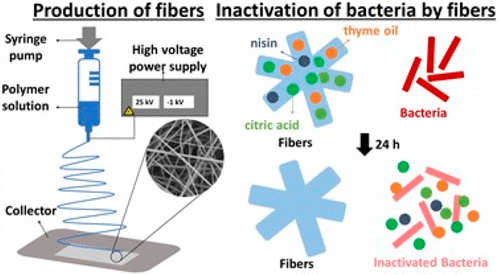当前位置:
X-MOL 学术
›
ACS Sustain. Chem. Eng.
›
论文详情
Our official English website, www.x-mol.net, welcomes your
feedback! (Note: you will need to create a separate account there.)
Development of Biodegradable and Antimicrobial Electrospun Zein Fibers for Food Packaging
ACS Sustainable Chemistry & Engineering ( IF 7.1 ) Pub Date : 2020-09-21 , DOI: 10.1021/acssuschemeng.0c05917 Zeynep Aytac 1 , Runze Huang 1 , Nachiket Vaze 1 , Tao Xu 1 , Brian David Eitzer 2 , Walter Krol 2 , Luke A. MacQueen 3 , Huibin Chang 3 , Douglas W. Bousfield 4 , Mary B. Chan-Park 5 , Kee Woei Ng 1, 6, 7 , Kevin Kit Parker 3 , Jason C. White 2 , Philip Demokritou 1, 6
ACS Sustainable Chemistry & Engineering ( IF 7.1 ) Pub Date : 2020-09-21 , DOI: 10.1021/acssuschemeng.0c05917 Zeynep Aytac 1 , Runze Huang 1 , Nachiket Vaze 1 , Tao Xu 1 , Brian David Eitzer 2 , Walter Krol 2 , Luke A. MacQueen 3 , Huibin Chang 3 , Douglas W. Bousfield 4 , Mary B. Chan-Park 5 , Kee Woei Ng 1, 6, 7 , Kevin Kit Parker 3 , Jason C. White 2 , Philip Demokritou 1, 6
Affiliation

|
There is an urgent need to develop biodegradable and nontoxic materials from biopolymers and nature-derived antimicrobials to enhance food safety and quality. In this study, electrospinning was used as a one-step, scalable, green synthesis approach to engineer antimicrobial fibers from zein using nontoxic organic solvents and a cocktail of nature-derived antimicrobials which are all FDA-classified Generally Recognized as Safe (GRAS) for food use. Morphological and physicochemical properties of fibers, as well as the dissolution kinetics of antimicrobials were assessed along with their antimicrobial efficacy using state of the art analytical and microbiological methods. A cocktail of nature-derived antimicrobials was developed and included thyme oil, citric acid, and nisin. Its ability to inactivate a broad-spectrum of with food-related pathogens was demonstrated. Morphological characterization of the electrospun antimicrobial fibers revealed bead-free fibers with a small average diameter of 165 nm, whereas physicochemical characterization showed high surface area-to-volume ratio (specific surface area:21.91 m2/g) and presence of antimicrobial analytes in the fibers. The antimicrobials exhibited initial rapid release from the fibers in 2 h into various food simulants. Furthermore, the antimicrobial fibers effectively reduced E. coli and L. innocua populations by ∼5 logs for after 24 h and 1 h of exposure, respectively. More importantly, due to the small diameter and high surface area-to-volume ratio of the fibers, only miniscule quantities of fiber mass and antimicrobials per surface area (2.50 mg/cm2 of fibers) are needed for pathogen inactivation. The scalability of this fiber synthesis process was also demonstrated using a multineedle injector with production yield up to 1 g/h. This study shows the potential of using nature-derived biopolymers and antimicrobials to synthesize fibers for sustainable food packaging materials.
中文翻译:

食品包装用可生物降解和抗菌静电纺玉米蛋白纤维的开发
迫切需要从生物聚合物和天然抗菌剂开发可生物降解的无毒材料,以提高食品安全性和质量。在这项研究中,静电纺丝是一种一步法,可扩展的绿色合成方法,可使用无毒有机溶剂和天然来源的抗菌剂混合物(包括所有FDA公认的安全性(GRAS))从玉米蛋白中改造抗菌纤维。食物使用。使用最先进的分析和微生物方法评估了纤维的形态和理化性质,以及抗菌剂的溶解动力学及其抗菌功效。开发了一种自然界抗菌药物混合物,其中包括百里香油,柠檬酸和乳链菌肽。证明了它具有灭活与食物有关的病原体的广谱能力。电纺抗菌纤维的形态学表征显示无珠纤维,平均直径为165 nm,而理化特性显示高的表面积体积比(比表面积:21.91 m2 / g)和纤维中存在抗菌分析物。抗菌剂在2小时内显示出从纤维中快速释放到各种食品模拟物中。此外,抗微生物纤维有效地减少大肠杆菌和无害利斯特氏菌由〜5个日志分别为24小时,并暴露1个小时,之后的人群。更重要的是,由于纤维的直径小且表面积/体积比高,因此每表面积的纤维量和抗菌剂的量极少(2.50 mg / cm 2纤维)是病原体灭活所必需的。还使用多针注射器证明了该纤维合成工艺的可扩展性,其生产率高达1 g / h。这项研究表明,使用自然来源的生物聚合物和抗菌剂来合成可持续食品包装材料的纤维的潜力。
更新日期:2020-10-12
中文翻译:

食品包装用可生物降解和抗菌静电纺玉米蛋白纤维的开发
迫切需要从生物聚合物和天然抗菌剂开发可生物降解的无毒材料,以提高食品安全性和质量。在这项研究中,静电纺丝是一种一步法,可扩展的绿色合成方法,可使用无毒有机溶剂和天然来源的抗菌剂混合物(包括所有FDA公认的安全性(GRAS))从玉米蛋白中改造抗菌纤维。食物使用。使用最先进的分析和微生物方法评估了纤维的形态和理化性质,以及抗菌剂的溶解动力学及其抗菌功效。开发了一种自然界抗菌药物混合物,其中包括百里香油,柠檬酸和乳链菌肽。证明了它具有灭活与食物有关的病原体的广谱能力。电纺抗菌纤维的形态学表征显示无珠纤维,平均直径为165 nm,而理化特性显示高的表面积体积比(比表面积:21.91 m2 / g)和纤维中存在抗菌分析物。抗菌剂在2小时内显示出从纤维中快速释放到各种食品模拟物中。此外,抗微生物纤维有效地减少大肠杆菌和无害利斯特氏菌由〜5个日志分别为24小时,并暴露1个小时,之后的人群。更重要的是,由于纤维的直径小且表面积/体积比高,因此每表面积的纤维量和抗菌剂的量极少(2.50 mg / cm 2纤维)是病原体灭活所必需的。还使用多针注射器证明了该纤维合成工艺的可扩展性,其生产率高达1 g / h。这项研究表明,使用自然来源的生物聚合物和抗菌剂来合成可持续食品包装材料的纤维的潜力。











































 京公网安备 11010802027423号
京公网安备 11010802027423号